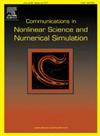Numerical simulation of synchronous flapping and twisting oscillations to enhance aerodynamic performance of wing
IF 3.8
2区 数学
Q1 MATHEMATICS, APPLIED
Communications in Nonlinear Science and Numerical Simulation
Pub Date : 2025-09-24
DOI:10.1016/j.cnsns.2025.109358
引用次数: 0
Abstract
The primary objective of this study is to design and optimize the wing to improve its aerodynamic performance. Three-dimensional, transient, incompressible, and turbulent flow is considered for simulations. To develop a mechanical model of the wing, this study used a combination of mathematical and numerical modeling techniques. The Navier-Stokes equations with the effects of gravity are applied and the finite-volume method (FVM) is used to solve the problem. This research aims to simulate the dynamics of the wings using dynamic grid methods. Consequently, the wing is allowed to flap and twist at varying angles to determine its aerodynamic parameters. It is postulated that the linear motion of the wing is zero, whereas its angular motion is taken into account. The analysis comprises both the flapping angle, which describes the oscillation, and the twisting angle, which characterizes the twisting motion of the wing. The results show a high degree of agreement with previous work.
提高机翼气动性能的同步扑动和扭转振荡数值模拟
本研究的主要目的是设计和优化机翼,以提高其气动性能。三维、瞬态、不可压缩和紊流被考虑用于模拟。为了建立机翼的力学模型,本研究结合了数学和数值建模技术。采用考虑重力作用的Navier-Stokes方程,采用有限体积法求解该问题。本研究旨在利用动态网格方法模拟机翼的动力学特性。因此,机翼被允许以不同的角度拍打和扭曲,以确定其空气动力学参数。假设机翼的直线运动为零,而考虑其角运动。分析既包括描述机翼振荡的扑动角,也包括表征机翼扭转运动的扭转角。所得结果与前人的研究结果高度吻合。
本文章由计算机程序翻译,如有差异,请以英文原文为准。
求助全文
约1分钟内获得全文
求助全文
来源期刊

Communications in Nonlinear Science and Numerical Simulation
MATHEMATICS, APPLIED-MATHEMATICS, INTERDISCIPLINARY APPLICATIONS
CiteScore
6.80
自引率
7.70%
发文量
378
审稿时长
78 days
期刊介绍:
The journal publishes original research findings on experimental observation, mathematical modeling, theoretical analysis and numerical simulation, for more accurate description, better prediction or novel application, of nonlinear phenomena in science and engineering. It offers a venue for researchers to make rapid exchange of ideas and techniques in nonlinear science and complexity.
The submission of manuscripts with cross-disciplinary approaches in nonlinear science and complexity is particularly encouraged.
Topics of interest:
Nonlinear differential or delay equations, Lie group analysis and asymptotic methods, Discontinuous systems, Fractals, Fractional calculus and dynamics, Nonlinear effects in quantum mechanics, Nonlinear stochastic processes, Experimental nonlinear science, Time-series and signal analysis, Computational methods and simulations in nonlinear science and engineering, Control of dynamical systems, Synchronization, Lyapunov analysis, High-dimensional chaos and turbulence, Chaos in Hamiltonian systems, Integrable systems and solitons, Collective behavior in many-body systems, Biological physics and networks, Nonlinear mechanical systems, Complex systems and complexity.
No length limitation for contributions is set, but only concisely written manuscripts are published. Brief papers are published on the basis of Rapid Communications. Discussions of previously published papers are welcome.
 求助内容:
求助内容: 应助结果提醒方式:
应助结果提醒方式:


